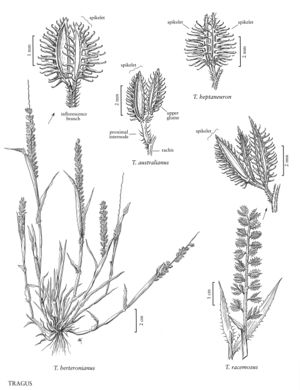Difference between revisions of "Tragus berteronianus"
FNA>Volume Importer |
FNA>Volume Importer |
||
| Line 17: | Line 17: | ||
-->{{Treatment/Body | -->{{Treatment/Body | ||
|distribution=Maine;Puerto Rico;Mass.;N.Mex.;Tex.;Va.;Virgin Islands;N.Y.;Pacific Islands (Hawaii);S.C.;Ariz. | |distribution=Maine;Puerto Rico;Mass.;N.Mex.;Tex.;Va.;Virgin Islands;N.Y.;Pacific Islands (Hawaii);S.C.;Ariz. | ||
| − | |discussion=<p | + | |discussion=<p>Tragus berteronianus is native to Africa and Asia, and is now established in Arizona, New Mexico, and Texas. It was collected in Maine, Massachusetts, New York, and Virginia in the nineteenth century, and Virginia in 1959.</p> |
|tables= | |tables= | ||
|references= | |references= | ||
| Line 33: | Line 33: | ||
|basionyms= | |basionyms= | ||
|family=Poaceae | |family=Poaceae | ||
| + | |illustrator=Linda A. Vorobik and Annaliese Miller | ||
|distribution=Maine;Puerto Rico;Mass.;N.Mex.;Tex.;Va.;Virgin Islands;N.Y.;Pacific Islands (Hawaii);S.C.;Ariz. | |distribution=Maine;Puerto Rico;Mass.;N.Mex.;Tex.;Va.;Virgin Islands;N.Y.;Pacific Islands (Hawaii);S.C.;Ariz. | ||
|reference=None | |reference=None | ||
| Line 38: | Line 39: | ||
|publication year= | |publication year= | ||
|special status= | |special status= | ||
| − | |source xml=https:// | + | |source xml=https://bibilujan@bitbucket.org/aafc-mbb/fna-data-curation.git/src/314eb390f968962f596ae85f506b4b3db8683b1b/coarse_grained_fna_xml/V25/V25_923.xml |
|subfamily=Poaceae subfam. Chloridoideae | |subfamily=Poaceae subfam. Chloridoideae | ||
|tribe=Poaceae tribe Cynodonteae | |tribe=Poaceae tribe Cynodonteae | ||
Revision as of 16:19, 30 October 2019
Plants annual. Culms (2)3.5-45 cm. Ligules 0.5-1 mm; blades (0.5)0.7-8.5 cm long, 1.2-5 mm wide, glabrous. Panicles (1)2-13 cm long, (3)4-8 mm wide; rachises pubescent; branches (0.5)0.7-2.7 mm, pubescent, with 2(3) spikelets, axes occasionally extending past the distal spikelets; proximal internodes 0.2-0.6(0.7) mm, shorter than the second internodes. Proximal spikelets (1.8)2^.3 mm; second spikelets (0.8)1-3.9 mm, some¬times sterile. Lower glumes 0.1-0.6 mm, membranous, minutely pubescent; upper glumes 1.8-4.3 mm, minutely pubescent, 5-veined, rarely with 1-2 additional veins adjacent to the midvein; glume projections (4)6-14, in 5 rows, (0.2)0.3-1 mm, uncinate; lemmas (1.5)1.8-3.1 mm, sparsely pubescent on the back, midveins occasionally excurrent to 0.6 mm; paleas (1.3)1.5-2.4 mm; anthers 3, 0.4-0.6 mm, yellow, occasionally purple-or green-tinged. Caryopses (0.9)1.2-2 mm long, 0.4-0.8 mm wide. 2n = 20.
Distribution
Maine, Puerto Rico, Mass., N.Mex., Tex., Va., Virgin Islands, N.Y., Pacific Islands (Hawaii), S.C., Ariz.
Discussion
Tragus berteronianus is native to Africa and Asia, and is now established in Arizona, New Mexico, and Texas. It was collected in Maine, Massachusetts, New York, and Virginia in the nineteenth century, and Virginia in 1959.
Selected References
None.
